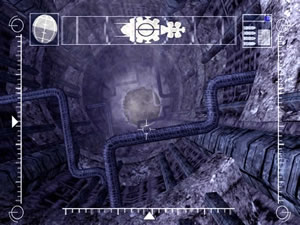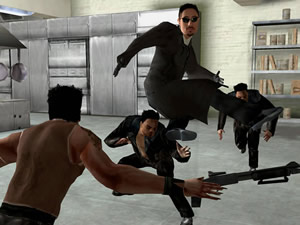Jacked by the Matrix.
Whenever someone jacks into The Matrix, it seems like they’re always clad
in Versace leathers and stylish sunglasses. I suppose one explanation is that
appearance is a physical manifestation of the id. Either that or everyone is just
tired of wearing ratty cotton sweaters.
The same rules apply in the game Enter the Matrix. Underneath the glamorous
surface and the ability to have some bullet time combat fun is just one ratty
sweater of a game.
The
story of Enter the Matrix runs parallel to the events in the second Matrix
movie, The Matrix Reloaded. Captain Niobe, played by Jada Pinkett-Smith,
and First Mate Ghost, played by Anthony Wong, must embark on various missions,
such as recovering covert information, protecting other ship captains in the
sewers, and helping out Neo by blowing up a nuclear reactor.
Jada and Anthony ham it up during small FMV vignettes. While it’s interesting
to see an event referenced in the movie take place in the game, the manner in
which it is done is relatively slipshod. Enter the Matrix lacks a cogent
narrative and feels very pieced together.
The gameplay shares that same erratic quality with its fusion of third-person
perspective meandering maze stages with some very undercooked driving and rail
shooting sequences.
The gameplay pits your choice of Niobe or Ghost against armies of Swat Teams, Vampires and Agents in two different individualized quests. Thankfully, Niobe and Ghost aren’t completely hopeless. They know kung fu. Both characters have basic punches, kicks, and blocks, as well as simple combos. The fighting is generally loose and at times borders on button mashing.
Besides martial arts, Niobe and Ghost can arm themselves with a host of different guns, from shotguns to machine guns to sniper rifles, as well as a few types of grenades. The grenades are most effective in specific scenarios; otherwise, there’s a tendency for them to bounce off objects right back at you, perhaps because your characters have such a weenie throw.
The defining element of The Matrix, bullet-time slow motion, is incorporated
through an ability called “Focus.” Your character has a limited yet rechargeable
meter that lets you deftly slow down, as well as granting additional flips and
dives. Your character will usually take less damage in Focus mode. Obviously,
this bears a striking resemblance to Max
Payne, and comparisons are sort of inevitable.
 In
In
Max Payne, the slow motion had a more noticeable advantage because aiming
could still be done in relative real time via the mouse. Enter the Matrix
has auto aiming, so to a limited degree, you can try pointing the gun at as
many enemies as possible while in a cartwheel. It does have its moments, like
leaping into a room, popping the officer to your left full of lead while readying
a kick to the head off a wall at the policeman in front of you.
But in the end, Focus is style before substance, as it mainly comes in handy only when faced by a gang of enemies. It’s neat, but you can largely do just as well kicking and punching and shooting the bad guys in real-time.
Once you look past the Focus mode, Enter the Matrix starts to show
its seams. Behold the poorly done driving game with a wonked out, buggy arrow
that’s supposed to point out the way, Crazy Taxi style, but never seems
to get it right. Then there are the fixed-rail shooting stages, some of which
feel like Sewer Shark all over again, just making you aim at things with
a cursor. Gameplay freedom? Who needs it.
What I’d liked to be freed from are the irritating load times, particularly
in the PS2 and Gamecube versions. When the game asks me posthumously whether
or not I want to jack back in the Matrix, I think it should really be whether
or not I want to be jacked by the Matrix again.
To give you a better feel for the movie, there’s a “hacking” option which
is essentially just a DOS emulator. There are no instructions to help you out,
so much of this area is touch and go. Jog your memory and try to remember some
of those old commands to access FMVs, view images and input some cheats. It’s
a cute, quirky flashback for those of us old enough to remember fumbling through
DOS, but younger gamers might want to look up some of those commands.
 The
The
game also suffers from a lack of immersion, just yanking you back and forth
from gameplay to loading. Finish off all the enemies and wham, its back to the
loading screen of green characters scrolling downwards.
That familiar scroll of code permeates every inch of the game, but the visuals
also include some good environmental texture work and the neato bullet time
effects. But there are many graphical flaws here, such as rigid and unconvincing
character animation as well as frequent visual bugs and tearing. The PS2 version
is the ugliest, with the Gamecube a close second and the Xbox looking the best,
but even the green machine version won’t be winning any awards.
At times, the music can be outright atrocious. Throughout the sewers, the audio is tuned to the action – the moment you get into a firefight, this clashing disharmony of sound just starts banging away. It’s as if it’s urging you to kill as quickly as possible just to stop the aural suffering. Other moments in the game feature musical selections from the movie with no sense of mood, pace or environment. Well, at least the gunshots and plinks of empty ammo cartridge sound just right.
Enter the Matrix is an unrealized dream that tries to bring movies
and games together and comes up far short. It’s blatantly obvious that this
game isn’t quite finished. Unfortunately, that tends to happen when you tie
in the release of the game with the film. While it does have its moments and
diehard Matrix fans will drool over the extra videos, this game receives
the blue pill.

*all screenshots from PS2 version
-
"Focus" Bullet Time
-
Kung-fu and guns combat
-
Attempt at a side story
-
Lack of decent narrative
-
Buggy, unpolished
-
Long load times
-
Bland level design
-
Weak driving and fixed rail levels
-
Annoying music, shoddy visuals







